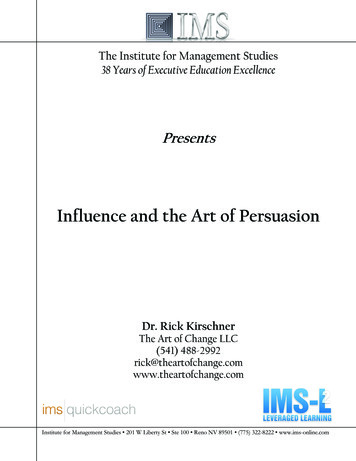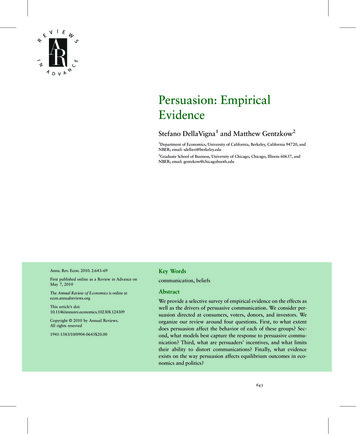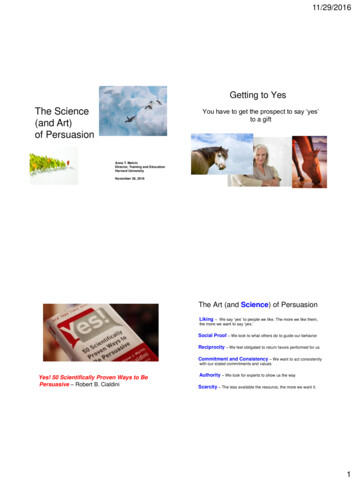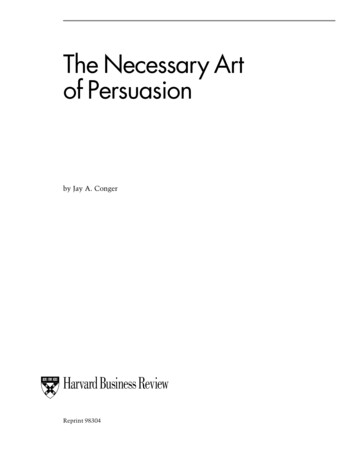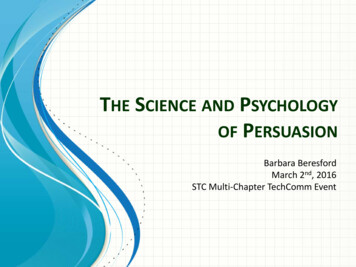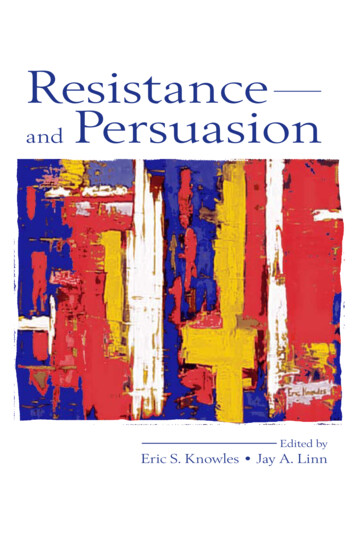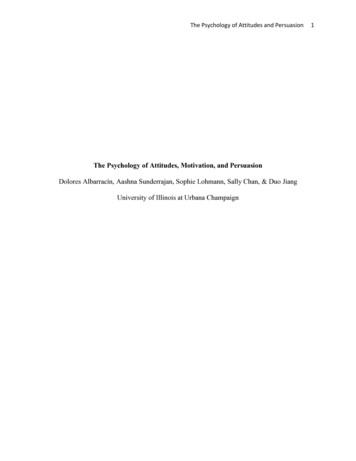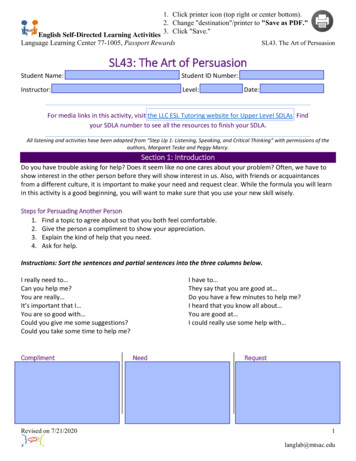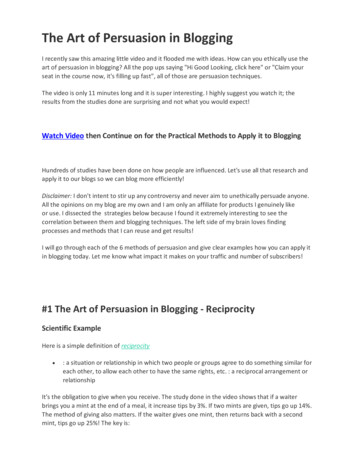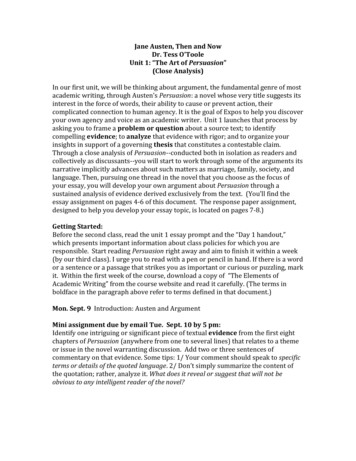
Transcription
Jane Austen, Then and NowDr. Tess O’TooleUnit 1: “The Art of Persuasion”(Close Analysis)In our first unit, we will be thinking about argument, the fundamental genre of mostacademic writing, through Austen’s Persuasion: a novel whose very title suggests itsinterest in the force of words, their ability to cause or prevent action, theircomplicated connection to human agency. It is the goal of Expos to help you discoveryour own agency and voice as an academic writer. Unit 1 launches that process byasking you to frame a problem or question about a source text; to identifycompelling evidence; to analyze that evidence with rigor; and to organize yourinsights in support of a governing thesis that constitutes a contestable claim.Through a close analysis of Persuasion--conducted both in isolation as readers andcollectively as discussants--you will start to work through some of the arguments itsnarrative implicitly advances about such matters as marriage, family, society, andlanguage. Then, pursuing one thread in the novel that you choose as the focus ofyour essay, you will develop your own argument about Persuasion through asustained analysis of evidence derived exclusively from the text. (You’ll find theessay assignment on pages 4-6 of this document. The response paper assignment,designed to help you develop your essay topic, is located on pages 7-8.)Getting Started:Before the second class, read the unit 1 essay prompt and the “Day 1 handout,”which presents important information about class policies for which you areresponsible. Start reading Persuasion right away and aim to finish it within a week(by our third class). I urge you to read with a pen or pencil in hand. If there is a wordor a sentence or a passage that strikes you as important or curious or puzzling, markit. Within the first week of the course, download a copy of “The Elements ofAcademic Writing” from the course website and read it carefully. (The terms inboldface in the paragraph above refer to terms defined in that document.)Mon. Sept. 9 Introduction: Austen and ArgumentMini assignment due by email Tue. Sept. 10 by 5 pm:Identify one intriguing or significant piece of textual evidence from the first eightchapters of Persuasion (anywhere from one to several lines) that relates to a themeor issue in the novel warranting discussion. Add two or three sentences ofcommentary on that evidence. Some tips: 1/ Your comment should speak to specificterms or details of the quoted language. 2/ Don’t simply summarize the content ofthe quotation; rather, analyze it. What does it reveal or suggest that will not beobvious to any intelligent reader of the novel?
2Wed. Sept. 11Evidence and AnalysisRead as far into Persuasion as you can; our discussion will focus largely on the firstthird of the novel, as we start to tease out some of the contestable subjects itaddresses by close analysis of textual evidence: key passages.Mon. Sept. 16Questions and Claims (Finish Persuasion by today.) Also review the handout“Asking an Analytic Question” (posted on the class website).Wed. Sept. 18Shaping an Argument: Analysis and StructureFor today, read the following close analysis essay from the 2010 issue of Exposé:Madeline Magnuson’s “Jane Eyre: The Bonds of Matrimony,” which you can accessthrough the Writing Program’s home page:http://www.people.fas.harvard.edu/ expose/issues/issue 2010/magnuson.htmlA list of questions about the sample essay to help you prepare for class isposted on the website (under “Handouts”). You are not required to submitwritten responses to those questions, but you must be prepared to discussthem in class.Fri. Sept. 20Response Paper #1 is due by 9 am. Watch your inbox over the next 2 days forfeedback; sign up on the website for an appointment on Monday if you want to talkabout that feedback and/or further thoughts for the draft.Mon. Sept. 23What’s at Stake? Or, How to Write an Effective IntroductionPrepare by carefully reading the handout “Introductions and Motive,” posted on theclass website (under “Handouts”).Reading and mini assignment for this week: From The Harvard Guide to UsingSources, read “Introduction,” “Why Use Sources,” and “Avoiding Plagiarism.” Emailme by midnight Tuesday Sept. 24 (i.e., before Wed. morning) to confirm that youhave read this assignment, and include in your email any questions you might haveabout it.Wed. Sept. 25“Elements” review and “transferability” discussionFri. Feb. 27Draft of essay 1 due by 9 am.
3Mon. Sept. 30Workshop of Unit 1 DraftsFollow workshop directions posted on the class website.Conferences held Mon. Feb. 25-Wed. Feb. 27; revisions due 6 days after yourconference.Wed. Oct. 2Visit to Houghton Library to view Austen materials. Class meets today in the lobbyof Houghton Library.
4Essay #1 Close Analysis of Persuasion5-6 pagesDeadlines, etc.:Draft due Friday, Sept. 20 by 9 am, by email, as an attachment in doc or docxformat. You are also required to submit a hard copy of the same document; bring itto class on Monday.Revision due 6 days after your conference date by 5 pm, posted in doc or docxformat to the unit 1 folder in the dropbox on the course website. Also submit ahard copy of the revision to my box at 1 Bow St. (or to me in class if applicable) nolater than noon the following day. Your draft with my comments on your draftmust be submitted as well at that time; paperclip it to the hard copy of yourrevision. For both draft and revision, be sure to follow the formattinginstructions that are posted on the class website and remember to cite yoursource in MLA format.The assignment:Our study of Austen begins with a concentrated reading of Persuasion. Byscrutinizing the author’s last published novel, whose marriage plot unfolds in thecontext of a society in transition, we are attempting to arrive at a deeperunderstanding of what’s at stake in Austen’s fiction. Your unit 1 writing assignmentis likewise an exercise in concentrated reading; in this first essay, you will explore aproblem or issue in the novel by undertaking a close analysis of relevant, selectedtextual evidence. (Identifying that issue, one that interests you and that you candiscuss in a way that sustains a reader’s interest, will be a major step in thedevelopment of this essay; college-level writing assignments often require you todevelop your own question to address.) The “elements of academic writing” thatthis assignment prioritizes (and therefore the elements most heavily weighted inthe evaluation of your essay) are evidence; analysis; thesis; and defining the“question or problem.”Evidence:Close analysis essays (or close readings, to use the term more often adopted inliterature classes) are built out of material the writer pulls out of the source text. Inother words, evidence in the text generates the question the essay proposes to answeras well as the means to arrive at an answer (in the form of a thesis claim). In a onesource close analysis assignment like this, it’s essential that you don’t consultoutside sources or browse the Web to brainstorm. Instead, turn to the text of thenovel--to its language, especially--in search of questions, ideas, and inspiration. (Asyou are reading the novel, read with a pen or pencil in hand so you can mark lines orpassages that seem particularly important or puzzling to you. Reviewing what youmarked will help get you started when it’s time to sit down to figure out what mightbe worth writing about.)
5One feature of writing about a novel as opposed to, say, a sonnet, is that you can’tdeal with the entire text. Therefore, a close analysis of a novel generally focuses ona few specific passages that speak to a common issue or problem. Your challenge isto find specific moments in the text that bring a broader issue or problem intoparticular focus. These crystallizing passages will provide the building blocks forthe argument you construct. (A passage might be as short as a paragraph or as longas a scene that plays out over several pages. Remember that it’s better to discuss afew pieces of evidence in depth and detail than to treat numerous passages moresuperficially.)There are many issues a reader might find interesting or puzzling in Persuasion:issues including, to name just a few, ambiguities or complications in the novel’streatment of social class; contrasting versions or notions of family; the tensionbetween the importance of discretion on the one hand and the importance of frankand effective communication on the other. Your first response paper will ask you toidentify and start to work through two or three passages, each of which sheds lighton an issue or idea or problem you think is worth writing about.Analysis:As a critical practice, close analysis of a text requires careful attention to the writer’slanguage. As you discuss your evidence in the essay, it’s important to bear in mindthe distinction between summary and analysis. The point of close reading or closeanalysis isn’t to summarize what the text literally says, but rather to interrogate andexplain underlying meanings and implications of your textual evidence. Youranalysis should reveal something to your reader that he or she would not see withoutthe intervention of your critical intelligence. Think about implicit as well as explicitmeanings, about what value systems seem to be operating in the fictional worldyou’re writing about, and about the way elements like word choice and sentencestructure advance the communication of ideas and values. (If the passage employsspecific rhetorical devices like allusion, imagery, or metaphor, you’ll want to thinkabout their significance. Remember, though, that the point isn’t to identify literarydevices as such, but rather to explicate the meaning they help to convey, if thosemeanings are relevant to your argument about the novel.)Thesis:Your thesis should advance a claim about the issue or topic or problem that yourpassages allow you to interrogate. It should be an analytic claim, not a descriptivestatement, i.e., a proposition that is not self-evident. (In class we’ll discuss thisdistinction and the features that make for a strong college-level thesis claim.) Thebest close analysis arguments are formed when a writer allows her reflection on thetextual evidence to lead her to a thesis claim (rather than looking to the text tosupport a thesis generated in advance of that reflection on the evidence).Defining the “Question or Problem”:A major goal of your introduction is to communicate to the writer not only what thefocus of the essay is, but why. What question or problem will the analysis address?
6Why is that a significant question or problem? That gives the reader a sense ofwhat’s at stake in the thesis claim the essay announces and develops. The handout“Introductions and Motive,” posted on the course website, provides some guidelinesand suggestions for the treatment of our fourth prioritized “element” as you fashionyour introduction.Writing Beyond Expos (Or, How to Transfer What You’re Learningin Unit 1 to Other Writing Assignments)In literature classes, close analysis will generally be referred to as “closereading.” That term can be used as a noun or a verb; it is both a commonessay genre in literature departments, and a method of analysis you canemploy at key moments in virtually any kind of essay about literature. It ispracticed as well in history classes, where you might be expected toperform textual analysis of a document. In other humanities classes,you’re likely to encounter analogous writing assignments. In an art historycourse, for example, you might be asked to analyze a painting or asculpture; though the “language” in visual rather than verbal, the idea isthe same: you’re looking closely at the formal elements that make up awork of art and explaining how they communicate specific meanings, justas you are doing in your essay on a Jane Austen novel. In the socialsciences, students are often asked to perform close analysis of argumentsor theories. This kind of assignment is similar to literary close reading inthat you are looking to the text for your evidence and building your thesisout of a careful unpacking of that text. However, you will probably do lesssentence-level analysis than you would in a literary close analysis; yourscrutiny of the text will likely focus more on such elements as claims,assumptions, logic, and evidence. Such assignments may be encountered insophomore tutorials, where students are sometimes asked to write aboutseminal essays in that academic discipline.
7Unit 1 Response PaperDue Friday, Sept. 20 by 9 am. Email it to me in doc or docx format, and also drop off ahard copy to 1 Bow St. (1 hour grace period for hard copy delivery)A response paper in Expos represents the first stage of your essay-in-development.However, it is not a draft of your draft; rather, it is a distinct writing exercise whoseterms are intended to help you develop building blocks for the draft. Your responsepaper assignment for Unit 1 asks you to identify a focus for your close analysis essay; toisolate potential evidence; and to perform preliminary analysis of some of thatevidence. Please label your sections by number (corresponding to the prompt). Withrespect to spacing, font, etc., follow the formatting instructions for essay submissionsposted on the website.I. Identify the question or issue you propose to explore in your Unit 1 essay.Explanation/Directions for Part I: To write this paper, you need to identify acontestable issue in Austen’s Persuasion that will provide the subject for an argumentyou will construct about the novel. The unit 1 syllabus proposes that Persuasionimplicitly advances arguments about various matters (matters that include, to namejust a few, social class and class mobility; the role of women in society; and changingdefinitions of family). Contestability might adhere as well to specific characters thatrepresent a problem or tension in the novel, or keywords that provide a clue to one ofthe novel’s implicit “arguments.” In Part I, you are to articulate in several sentences ora short paragraph the issue you propose to explore in your close analysis ofPersuasion. Bear in mind that your essay will requires a specific focus, a particularangle on the contestable issue your address addresses. For instance, while “the role ofwomen in society as reflected in Persuasion” is too broad a topic for the kind of essayyou will be writing, considering what Persuasion suggests about the different kinds ofpower available to middle class versus aristocratic women is a usefully specificapproach. If you like, you may identify your focus by posing an analytic question youressay will address. (Be sure to review the handout titled “Analytic Questions” that isposted on the website.) As you frame your response to Part I, consider how discussionof this issue will contribute to a better understanding of the stakes of Austen’s novel.(That will help prepare you to write a strong introduction.)II. Identify 5 or 6 passages in the novel that bring your proposed topic into focusand that constitute evidence out of which you can build your argument.Directions: These pieces of evidence might be as short as a couple of sentences or aslong as a scene that unfolds over several pages. Indicate your selections by chapter anda very short description of what that selection is about.III. Write a preliminary analysis of two or three of these pieces of textualevidence. (go to next page)
8Directions: Choose the two or three passages that you think are meatiest, about whichyou can imagine writing the most at this stage in your thinking about the essay-indevelopment. Ideally, the passages you choose will cast somewhat different lights onthe issue; successful essays need tension and development, so you don’t want threepassages that illustrate precisely the same idea. See if you can make your second orthird passage choice one that complicates either or both of the others. Transcribe thosetwo or three passages (single space these transcriptions, or you can attach a photocopyof them if you prefer) and write a preliminary analysis of each (separately). The passageas a whole is proposed as evidence, but now you need to break that down further: whatdetails in the passage are telling? What do they tell us that is not immediately obvious?Aim to write about 1 ½-2 pages total of commentary for part III. (The transcription orphotocopy of the passages does not factor into the page length.)
9Jane Austen, Then and NowUnit 2: “Jane Austen at the Movies”Reading/Viewing assignments for Unit 2Our class sessions will focus on the film adaptations of Pride and Prejudice that arethe primary object of analysis for the Unit 2 essays. Because you will be making anargument about one of them as an adaptation, you need to have a handle on theAusten novel it is adapting. Therefore, you are responsible for reading (or rereading) Pride and Prejudice. (Do this as early in the unit as possible, but ifnecessary, you can use the gap between classes over the Columbus Day holiday tofinish reading the novel.) We will discuss selected clips from the film adaptations inclass, but you are required to view in their entirety episode 1 of the 1995 BBC miniseries (you’ll only need to watch the remaining episodes if that is the adaptation youchoose to write about); Joe Wright’s Pride & Prejudice; and Gurinder Chadha’s Brideand Prejudice. The 1940 Pride and Prejudice is optional viewing. The coursepack(available for purchase at Gnomon Copy) contains a required reading from TimothyCorrigan’s manual about film analysis that offers essential tips for working with filmevidence.SCHEDULE:Mon. Oct. 7 Adapting AustenCarefully read the Unit 2 essay and response paper prompts. Also read—as close toclass as possible—the final chapter of Pride and Prejudice. We will be comparingAusten’s terms of closure to some of the film adaptations' final scenes as a way ofthinking about adaptation.Wed. Oct. 9 Taking a Closer Look at Film EvidenceBefore today’s class, you are expected to have watched Wright’s adaptation andepisode 1 of the BBC mini series and to have read the Corrigan chapters.Mon. Oct 14 No Class (Columbus Day)Mini assignment due Tue. Oct. 15 by 5 pm. In an email, identify one specific shotor sequence from Bride and Prejudice that you think is worth pausing over. (“Shot”and “sequence” are terms drawn from the Corrigan reading.) In at least severalsentences and no more than one paragraph, explain what you find significant orinteresting about that piece of film evidence.Wed. Oct. 16 Reinventing AustenWe’ll be discussing Bride and Prejudice.Fri. Oct. 18 Response Paper 2 due by 9 am. Optional meetings Monday to discussresponse paper feedback and the draft plans.
10Mon. Oct. 21 Analyzing Film Evidence, cont’d.; forms of comparative analysiscomparisonWed. Oct. 23 Today we’ll discuss some “management on the page” issues pertinentto the Unit 2 essay, in particular representing film evidence on the page and citationof film evidence.Fri. Oct 25 Unit 2 Draft due 9 am.Mon. 28 Unit 2 Workshop (Drafts will be posted by Saturday afternoon.)Conferences Mon-Wed.Revisions due 5 days after your conference.Wed. Oct. 30TBA
11Essay 2:Pride and Prejudice as novel and film (6-7 pages)DRAFT due: Fri. Oct 25 by 9 am. Deliver a hard copy to my mailbox by noon.REVISION due 5 days after your conference by 5:00 pm via electronicsubmission to the dropbox. Get a hard copy to my mailbox by noon the next day (orto me in class if applicable). Remember to attach the draft with my comments tothat hard copy.In unit 2, you will write about one film adaptation of Austen’s most iconic novel,Pride and Prejudice, in order to advance an argument about some aspect of thatfilm in relation to the novel. Filmed versions from which you may choose are the1940 Hollywood classic with Greer Garson and Laurence Oliver; the 1995 BBCminiseries starring Colin Firth and Jennifer Ehle; Joe Wright’s 2005 film starringKeira Knightly and Matthew Macfadyen; and Gurinder Chadha’s 2004 Bollywoodinspired Bride and Prejudice. It can be helpful to think of the film as aninterpretation of the novel on which it is based, and also to think of the film as a textthat can be compared to Austen’s text. Think about what slant or emphasis the filmseems to place on Austen’s novel.To write this essay, you will need to focus on a particular aspect of the filmnovel relationship. Questions you might think about upon viewing the films tohelp you to arrive at your analytic focus for your essay about one of those filmsinclude the following:-- What happens to the characters, now performed by actors whose acting styles andphysical qualities contribute to characterization? What strikes you about a givenfilm’s characterization of Elizabeth, of Darcy, of Mr Bennet, etc.? What do these filmversions emphasize or change about their counterpart in the novel?--Are there significant changes to the original text (changes in dialogue, in narrativeevent, in detail, etc.), and if so, what do you think is at issue or at stake with thosealterations?--Is there a particular scene or episode in which the relationship between theoriginal and the adaptation is particularly interesting or revelatory?-- Does the film seem to highlight one particular aspect of Austen’s narrative?A number of things you worked on in Unit 1 will be transferable to this secondessay. As you did in the last essay, you will develop a contestable thesis claim; willsupport your argument with textual evidence; and will write an introduction thatcommunicates what’s at stake in the argument. You will also apply the specificanalytic practice you learned in unit 1, close analysis, to the evidence you isolate forcommentary. Whatever your argument is, its development will depend on carefulanalysis of film evidence. Since you are considering the film in relation to theadaptation of the novel on which it is based, some of your essays may also includesome “close reading” of passages from the novel, though in other cases briefer
12explications of pertinent elements in the novel will suffice. In other words, it followsfrom the terms of the assignment that the film will provide the majority of thespecific evidence you will closely analyze in this essay (just as you analyzedPersuasion’s terms of representation in Unit 1).While close reading a film is analogous to close reading literature, it requires you toanalyze visual language. As Timothy Corrigan explains in A Short Guide to WritingAbout Film, “Films are not just about a story, character, or place, or a way of life; theyare also what John Berger has called a ‘way of seeing’ those elements. . .To write anintelligent, perceptive analysis of the stories and characters in the movies, you mustbe prepared to see them as constructed. . .” (20, emphasis added). Therefore thewriter of an essay on film must communicate “not just what you see but how theimage makes you see people and things in a certain way and in a certain relationshipto one another” (Corrigan 56-7, emphasis added). To get a handle on working withthis new kind of evidence, carefully read the chapters from Timothy Corrigan’smanual that are included in the coursepack. These chapters from Corrigan providehelpful tips about what to look for in film images and will introduce you to thestandard vocabulary used to talk about the language of film. We will spend sometime in class collectively examining some shots or sequences from several Pride andPrejudice film adaptations in order to practice the analysis of film evidence. (I havealso placed a handout on the website that reviews relevant points from Corrigan;this document is intended as a supplement to Corrigan, not a substitute for theassigned reading.)Don’t undertake research for this essay; as in Unit 1, the point is for you to engagedirectly with the primary sources in order to generate an essay from your own ideasabout them. However, I will distribute a handout with some claims made by a criticor scholar about one of these adaptations--or about the phenomenon of adaptationitself—that may prove useful for furthering our own thinking about our Unit 2primary sources. If you would find it helpful to draw on one of those claims in yourintroduction in order to suggest what is stake in your argument, i.e., to helpestablish the essay’s “motive,” you may do so. If you do, confine your use of thesecondary source to your introductory framing; the body of the essay shouldconsist exclusively of your own textual analysis. Please note that this use of aclaim from a secondary source to help launch your argument is allowed but notrequired; it is equally possibly to derive the sense of “what’s at stake” from thefriction between the two primary sources, the novel and the film.
13Writing Beyond ExposYou are likely to be assigned many essays that require you to compare sources, ideas, or phenomena.Some will be straightforward comparisons (i.e., compare the cultural politics of Pride and Prejudicewith those of Persuasion), while others, like your Unit 2 Expos assignment, will ask you to considerone thing in relation to something else (in this case, a film in relation to the novel of which it is anadaptation), or to assess some idea with reference to different expressions of that idea (i.e., what’s thebest way to foster democracy, according to two or three different political theorists). In the case ofany essay predicated on comparison, it will be important to anchor your analysis and argument inspecific grounds for comparison; if those are not identified for you in the prompt, you need todevelop them. The goal of a comparative essay is to make your reader see something by consideringtwo (or sometimes more) sources, ideas, theories, or phenomena together that would not be as visibleif we only looked at each in isolation. Beware of simply cataloguing similarities and differences: incollege-level writing, those similarities and differences you observe between two things are likely tobe the starting point for an argument, but to move from description to analysis you must think aboutwhat those similarities or differences suggest or reveal. A good way to get started with a comparativeessay assignment is to ask yourself what you noticed about A when you looked at it in conjunctionwith B that you might not have picked up on if you weren’t thinking about it in those comparativeterms. (Comparison is a strategy for thinking as well as a kind of writing.) The Harvard CollegeWriting Center’s website has an excellent guide to writing comparative essays that you can find athttp://www.fas.harvard.edu/ wricntr/documents/CompAnalysis.html.That document provides tips for identifying strong grounds for comparison as you frame yourargument, for fashioning comparative thesis claims, and for structuring comparative essays. It alsodiscusses lens analysis, a cousin of the comparative essay in which you read one source through theinterpretive “lens” provided by another source.
14Response Paper # 2Due Fri. Oct. 18 by 9 am via email attachment. Drop off a hardcopy by noon.Remember to include your Works Cited.You will be watching several film adaptations of Pride and Prejudice. Before startingon the response paper assignment, you need to decide which one you will writeabout. (If you want to write about the BBC mini-series, you need to view it in itsentirety.) The first sentence of Part I should identify your choice of adaptation.Part I Analytic Focus*Write approximately one page (double-spaced) explaining the proposed analyticfocus of your two-source essay. What specific aspect of the relationship betweenthe film and Austen’s novel will you analyze? What invites, or what led you to,this specific focus, and what are your preliminary observations, questions, orconclusions?II. Preliminary Film AnalysisChoose one shot or scene that reflects particularly well what you are exploringabout the film adaptation. Write a preliminary analysis of that shot or scene. (Aimfor 2 solid paragraphs.) As you discuss this piece of film evidence, remember todraw on Corrigan’s tips about the formal elements of this medium and how to writeabout them.*If you are having trouble arriving at an analytic focus for your Unit 2 essay, trydoing the “brainstorming” exercise posted on the course website.
15Jane Austen, Then and NowO’Toole/Expos 20.142Unit 3: “Civil Discourse: Jane Austen and the Critics”Mon. Nov 4Library class with Sue Gilroy; today we meet in Lamont B30This class will teach you how to find sources to develop your independent researchproject on an Austen novel or adaptation. These are the required readings forthis class: 1/ the sections in HGUS on “Evaluating Sources” and “Locating Sources”and 2/ the essay and response paper prompts. Bring your laptop to this class if youcan; otherwise, you can use one of the loaner laptops in Lamont B30.Wed. Nov. 6Working with Secondary SourcesWhat kind of source is this? (or, judging a book by its cover);Engaging with secondary sources at the college levelBefore class, review the essay prompt, especially the second paragraph (the onedetailing source parameters).Mini assignment due by email by Friday Nov. 8, 9am Write me a briefdescription (a few sentences) of your research topic for Unit 3. What potentialsources have you found so far (sources additional to the novel or adaptation aboutwhich you are writing)?Mon. Nov. 11Reading Scholarly ArticlesRead the chapter by Claudia Johnson in the coursepack; a writing assignment due inclass will be distributed by email.Wed. Nov. 13 Source FunctionsFor today’s class, you will read a multi-source essay from Exposé and a handout onsource functions; both of these documents, along with instructions for how toprepare for class discussion, are posted on the website.Response Paper (the annotated bibliography) due Friday, Nov. 14 (any time)Once you have submitted your response paper, it’s time to work on formulatingyour essay plan. F
Unit 1: “The Art of Persuasion” (Close Analysis) In our first unit, we will be thinking about argument, the fundamental genre of most academic writing, through Austen’s Persuasion: a novel whose very title suggests its interest in the force of words, their ability to cause or prev
